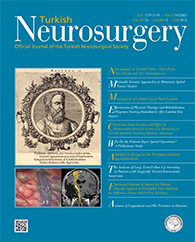MATERIAL and METHODS: Thirty cases of midline anterior skull base lesions were included in our study. Patients were operated upon by four routes: (i) unilateral subfrontal, (ii) bilateral subfrontal, (iii) frontotemporal approach, and (iv) bifrontal basal interhemispheric. Extent of resection was classified according to the Simpson grading system. The functional outcome of the patients was assessed by comparing the preoperative and the postoperative neurological examination, as well as the Karnofsky performance scale.
RESULTS: We had 14 OGMs (46.7%), 9 TSMs (30%), and 7 PSMs (23.3%). The most commonly utilized approach was the subfrontal approach (unilateral or bilateral) in 80% of the cases, followed by the pterional approach in 16.6% of the cases. Total removal was achieved in 86.7% of the cases; subtotal excision was achieved in 13.3% of the cases. 41.2% of our cases showed postoperative clinical improvement. We had two mortalities in our study, representing 6.7%. We did not detect any tumor recurrences in our follow up. The median preoperative Karnofsky scale was 85, while the median postoperative Karnofsky scale was 90.
CONCLUSION: Midline anterior skull base lesions are becoming amenable for total surgical excision with minimal morbidities and mortalities. Most preferred surgical routes are the subfrontal and the pterional approaches.
Keywords : Olfactory groove meningiomas, Planum sphenoidale meningiomas, Tuberculum sellae meningiomas, Simpson grade




